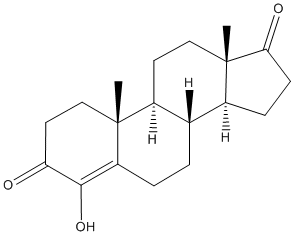All AbMole products are for research use only, cannot be used for human consumption.

Formestane (Lentaron (R)) is a second generation selective aromatase inhibitor with an IC50 of 80 nM. Formestane (Lentaron (R)) is used in the treatment of estrogen-receptor positive breast cancer in post-menopausal women. Formestane (Lentaron (R)) is often used to suppress estrogen production from anabolic steroids or prohormones. Formestane (Lentaron (R)) also acts as a prohormone to 4-hydroxytestosterone, an active steroid which displays weak androgenic activity in addition to acting as a mild aromatase inhibitor. Formestane has poor oral bioavailability and as such is no longer popular as many orally active aromatase inhibitors have been identified. Cells were treated with different aromatase inhibitors anastrozole, formestane, exemestane, and letrozole, or antiestrogens tamoxifen and fulvestrant. UMB-1Ca cells showed significant growth inhibition in response to fulvestrant (100 nM, P < 0.0005) and partial growth inhibition in response to letrozole (100 nM, P < 0.005).

Plant J. 2022 Jun;110(6):1636-1650.
Small molecule RHP1 promotes root hair tip growth by acting upstream of the RHD6-RSL4-dependent transcriptional pathway and ROP signaling in plants
Formestane purchased from AbMole
| Molecular Weight | 302.41 |
| Formula | C19H26O3 |
| CAS Number | 566-48-3 |
| Solubility (25°C) | DMSO 55 mg/mL |
| Storage |
Powder -20°C 3 years ; 4°C 2 years In solvent -80°C 6 months ; -20°C 1 month |
[1] Rajeev Kharb, et al. Aromatase inhibitors: Role in postmenopausal breast cancer
[3] Xavier de la Torre, et al. Detection of formestane abuse by mass spectrometric techniques
| Related Products |
|---|
| 2-Bromo-4-chlorophenylacetic acid
2-Bromo-4-chlorophenylacetic acid is a biochemical reagent. |
| CPN-351 TFA
CPN-351 TFA is a selective pentapeptide antagonist of human NMUR1 with a pA2 of 7.35. CPN-351 TFA can be used for the research of inflammation. |
| 5-Phenyluracil
5-Phenyluracil is a pyrimidine derivative, a class of heterocyclic aromatic organic compounds crucial in biochemistry. It serves as a synthetic nucleoside analogue, meaning it mimics the structure of naturally occurring nucleosides like uridine. This structural similarity allows it to participate in biochemical reactions, often interfering with normal cellular processes, making it a valuable tool in studying nucleic acid metabolism and developing antiviral and anticancer agents. |
| 7-Deoxyloganin
7-Deoxyloganin is a biosynthetic precursor of Loganin. 7-Deoxyloganin undergoes hydroxylation catalyzed by 7-deoxyloganin 7-hydroxylase, a cytochrome P450-dependent monooxygenase, to produce Loganin. |
| Mannose-BSA
Mannose-BSA is an important organic intermediate that combines the properties of mannose and bovine serum albumin, which is of unique value in the field of scientific research, and can be used as a key substance in a variety of organic synthesis reactions. Mannose is an important monosaccharide that binds specifically to mannose receptors (e.g., CD206 receptors on dendritic cells and macrophages), and therefore has a wide range of applications in immunomodulation and targeted drug delivery. BSA is a protein carrier that is commonly used for biocoupling, and its abundant surface amino groups can covalently bind to mannose to form a mannose-BSA complex. |
All AbMole products are for research use only, cannot be used for human consumption or veterinary use. We do not provide products or services to individuals. Please comply with the intended use and do not use AbMole products for any other purpose.


Products are for research use only. Not for human use. We do not sell to patients.
© Copyright 2010-2024 AbMole BioScience. All Rights Reserved.
